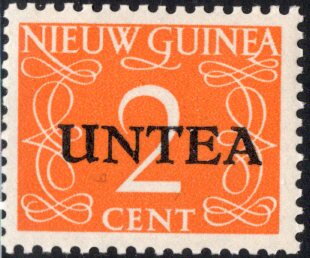Stamp: Numeral (Netherlands New Guinea 1962)
Numeral (Netherlands New Guinea 1962)
01 October (Netherlands New Guinea ) within release UNTEA Overprint - First Printing Hollandia goes into circulation Stamp Numeral face value 2 Dutch cent
| Stamp Numeral in catalogues | |
|---|---|
| Michel: | Mi: NL-WN 2I |
| Stamp Number: | Sn: NL-WN 2 |
| Yvert et Tellier: | Yt: NL-WN 2 |
| Stanley Gibbons: | Sg: NL-WN 2 |
| NVPH: | NVP: NL-WN 2 |
Stamp is square format.
First Print - the N of UNTEA is slightly lower than the remaining letters, base of T is flat or nearly so. Ink of overprint dull. Length of overprint 16.5-17.0mmAlso in the issue UNTEA Overprint - First Printing Hollandia:
- Stamp - Greater Bird-of-paradise face value 10;
- Stamp - Lesser Bird-of-paradise face value 1;
- Stamp - Lesser Bird-of-paradise face value 5;
- Stamp - Numeral face value 2;
- Stamp - Queen Juliana face value 25;
- Stamp - Queen Juliana face value 30;
- Stamp - Queen Juliana face value 40;
- Stamp - Queen Juliana face value 1;
- Stamp - Queen Juliana face value 2;
- Stamp - Queen Juliana face value 5;
- Stamp - Western Crowned Pigeon face value 17;
|
Data entry completed
53%
|
|
|---|---|
| Stamp Numeral in digits | |
| Country: | Netherlands New Guinea |
| Date: | 1962-10-01 |
| Perforation: | 12½ x 13½ |
| Emission: | Definitive |
| Format: | Stamp |
| Face Value: | 2 Dutch cent |
Stamp Numeral it reflects the thematic directions:
A number is a mathematical object used to count, measure, and label. The most basic examples are the natural numbers 1, 2, 3, 4, and so forth. Numbers can be represented in language with number words. More universally, individual numbers can be represented by symbols, called numerals; for example, "5" is a numeral that represents the number five. As only a relatively small number of symbols can be memorized, basic numerals are commonly organized in a numeral system, which is an organized way to represent any number. The most common numeral system is the Hindu–Arabic numeral system, which allows for the representation of any non-negative integer using a combination of ten fundamental numeric symbols, called digits. In addition to their use in counting and measuring, numerals are often used for labels (as with telephone numbers), for ordering (as with serial numbers), and for codes (as with ISBNs). In common usage, a numeral is not clearly distinguished from the number that it represents.

